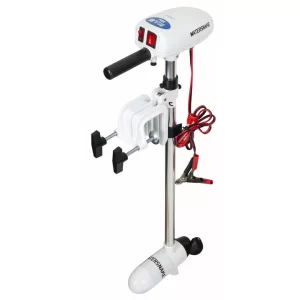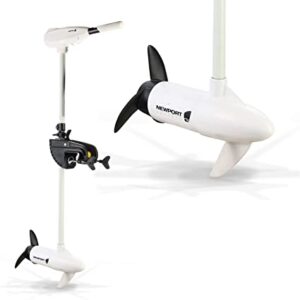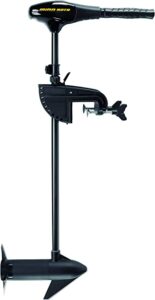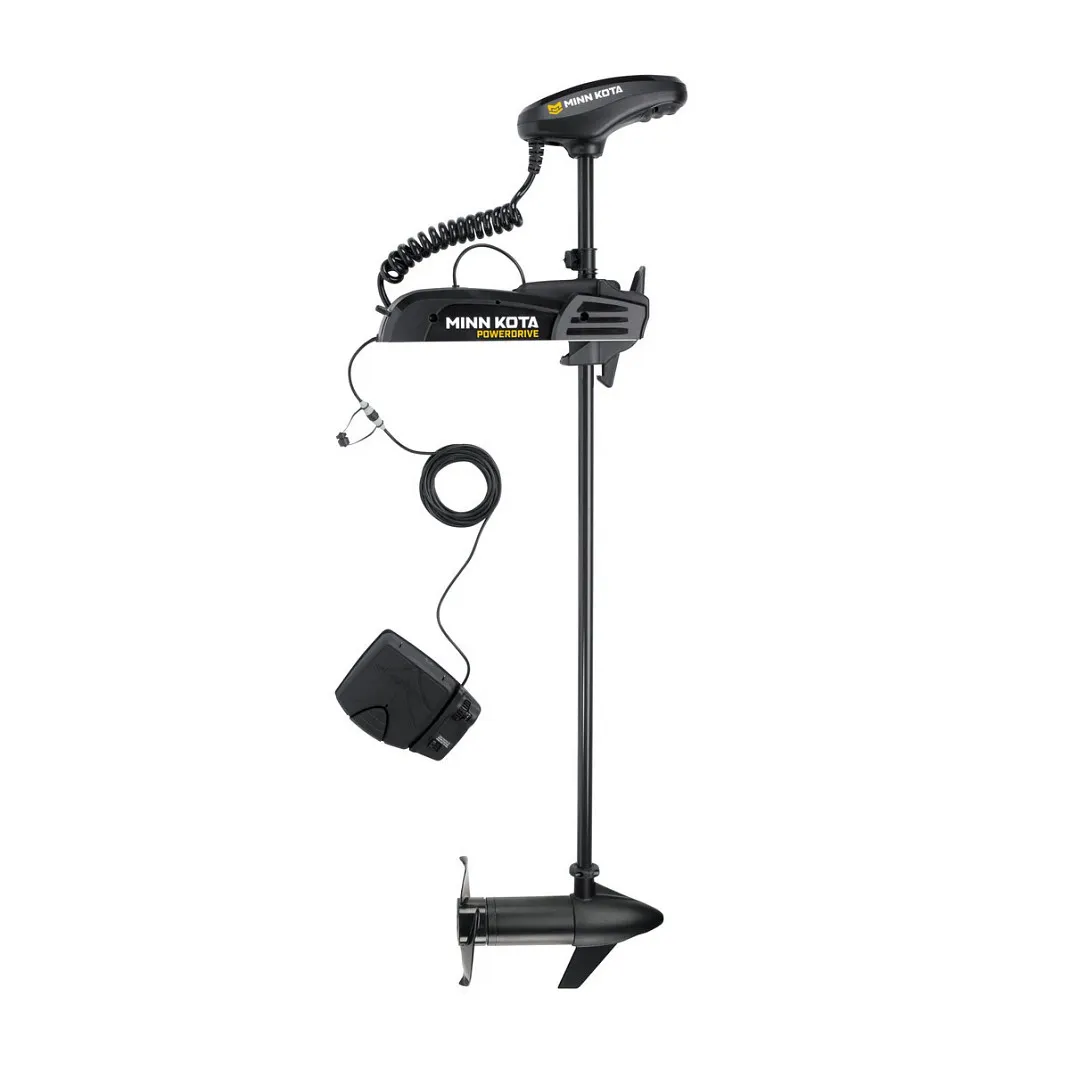| Watersnake Asp Saltwater Trolling Motor | Newport Vessels L-Series Transom Mount Electric Trolling Motor | Minn Kota Endura C2 Transom-Mount Trolling Motor |
|---|---|---|
 |
 |
 |
| Water Compatibility: Saltwater | Water Compatibility: Freshwater, saltwater, and brackish | Water Compatibility: Freshwater only |
| Thrust: 18 lbs / 24 lbs | Thrust: 62 lbs; 86 lbs | Thrust: Maximum thrust 30-55 lbs. depending on the model |
| Voltage: 12 V | Voltage: 12 V (62 lbs); 24 V (86 lbs) | Voltage: 12 volt |
| Speed Control: 2-forward, 2-reverse (low/high) | Speed Control: 5 forward; 3 reverse | Speed Control: 5 forward speeds, 3 reverse speeds |
| Control Type: Hand-tiller | Control Type: Hand-steer | Control Type: Hand |
| Mount Type: Transom/Kayak | Mount Type: Transom | Mount Type: Transom mount |
| Shaft Length: 24" | Shaft Length: 40” | Shaft Length: 30", 36", 42" |
| Shaft Material: Alloy | Shaft Material: Fiberglass | Shaft Material: indestructible composite shaft |
| Propeller Type: 2-blade | Propeller Type: 3 Blade (large) | Propeller Type: Power prop (includes washer, nut, and prop pin) |
| Battery Capacity: Varies | Battery Capacity: Variable (50+ Ah recommended) | Battery Capacity: 110AH recommended |
| Maximum Amp Draw: 15A / 20A | Maximum Amp Draw: 58A (62 lbs); 48A (86 lbs) | Maximum Amp Draw: 30-52 amps/hour, depending on the model |
| Warranty: 1-year | Warranty: 2-year limited warranty | Warranty: Limited lifetime warranty on composite shaft; limited two-year warranty on entire product |
| Spot Lock: No | Spot Lock: No | Spot Lock: No |
| Fish Finder Connectivity: No | Fish Finder Connectivity: None | Fish Finder Connectivity: No |
| Best Price (Amazon) | Best Price (Amazon) | Best Price (Amazon) Best Price (Bass Pro) |
THRUST
When it comes to delivering ample thrust in a small package ideal for kayaks, the Minn Kota Endura C2 tops the list. Available in 30, 35, and 55 lb thrust models, you can select the perfect power level to match your kayak's size and handling.
The Endura C2's max 55 lb thrust option provides surprising power from such a compact transom mount motor. It gives you enough push to get larger tandem kayaks or heavy loads moving without overwhelming smaller solo kayaks. This range of sizing means you can scale the thrust as needed.
Even at higher speeds the Endura C2 remains efficient and quiet thanks to Minn Kota's high-quality composite shaft and prop design. When optimizing thrust from a kayak trolling motor, the Endura C2 hits the sweet spot between power, efficiency, and suitable bulk for kayak usage.
WEIGHT
When cutting weight is your top priority for your kayak's trolling motor, it’s impossible to beat the incredibly light 5 lb Watersnake ASP Saltwater model. Removing every possible ounce makes a dramatic difference in keeping your kayak setup nimble and balanced.
The Watersnake ASP achieves its feathery light weight through an engineered composite shaft and plastic composite head and mount. This advanced composite construction provides surprising toughness and corrosion resistance for its weight.
An oversized kayak trolling motor can cause fatigue paddling the added weight all day or lead to stability issues. The Watersnake ASP allows you to cut weight without sacrificing thrust or quality. The light weight and small transom bracket are perfect for kayak installations where minimal mass is critical.
MOUNTING
Finding a trolling motor designed specifically for stable low-profile mounting on a kayak is a challenge most manufacturers haven’t solved. But the L-Series from Newport Vessels is purpose-built for kayak trolling.
The L-Series features an innovative mounting bracket that attaches directly and securely to the kayak cockpit using the existing scupper holes. This creates an unobtrusive rear-facing transom mount that doesn’t affect paddling or seating at all.
The low-profile bracket hugs the contour of the kayak, preventing the elevated profile issues and instability caused by transom mounts that sit too high off the kayak's surface. The Newport Vessels L-Series thinks through kayak mounting thoroughly with its clever scupper hole integration.

Selecting the right trolling motor is a critical decision when outfitting your kayak for fishing. The motor serves as your means of propulsion and precise control while on the water. However, kayaks have very different requirements compared to larger boats when it comes to trolling motors.
Kayaks are small, lightweight, low profile vessels. They demand compact trolling motors designed to match their size and stability characteristics. You can't simply slap a large outboard designed for bigger boats onto a kayak and expect ideal results.
In this guide, we'll cover the key factors to evaluate when selecting the best trolling motor specifically suited for kayak usage.
Thrust is an obvious starting point when selecting a kayak trolling motor. But you'll want to right-size the thrust to avoid both underpowering or overwhelming the handling of a kayak with too much force.
Look for lower thrust ratings in the 30 to 55 pound range when choosing a kayak trolling motor. This provides enough power to move small kayaks efficiently while maintaining control. High thrust motors designed for larger boats will be difficult to steer properly on a kayak.
Match the thrust to your kayak's length and weight capacity. Solo kayaks need less power than two-person tandem models. Go too low on thrust and you'll constantly be fighting the wind and current. But avoid overpowering the kayak's stability with excessive power.
A kayak trolling motor needs to be extremely lightweight compared to larger boat setups. Heavy motors lead to fatigue paddling all day and upset the delicate balancing of a kayak's trim.
Look for units that keep total weight under 10 pounds, or ideally 5 pounds. The Watersnake Venom is an excellent example at just 5.4 pounds. Super lightweight motors use composite materials in the shaft and head to shave every possible ounce.
A bulky 30+ pound trolling motor suited for a bass boat will quickly wear you out and raise your kayak's center of gravity. Keep it light to retain the kayak's natural agility both paddling and under power.
Kayak trolling motors must use transom mounts, not bow mounts designed for larger boats. Transom mounting is simpler, keeps weight closer to your center of gravity, and avoids obstacles.
The main goal is maintaining a low profile. Many transom mount brackets extend the motor too far off the kayak's surface, raising your center of gravity and compromising stability.
Look for low-slung mounting options like the Newport Vessels transom bracket that integrate cleanly with the kayak's existing scupper holes. This results in a barely raised profile. Proper kayak trolling motor mounting makes a big difference in performance.
On kayaks, having trolling motor controls that allow hands-free operation is crucial. Look for wireless remotes or tilt controls operable while sitting. This avoids constantly having to reach for a tiller handle while trying to paddle and fish.
Easy tilt adjustment lets you control speed and steering without removing hands from your paddle. Wireless remotes allow controlling direction and speed from anywhere in your kayak.
Hands-free operation is a challenge with kayaks, but key for simultaneously fishing. The best kayak trolling motors tackle this issue creatively.
Between saltwater use, bumping underwater obstacles, and UV exposure, kayak trolling motors take abuse. That's why you need maximum corrosion protection and durability in a compact package.
Look for composite fiberglass or carbon fiber shafts when possible - they provide amazing resilience for their weight. Plastic composite mounting brackets and heads also withstand constant underwater pressure and knocks better than metal.
Don't cheap out on materials for the sake of saving a few ounces. The composite construction found in higher-end motors like the Watersnake Venom will serve you well in the long run.
Prop design - Weedless wide props shed debris well and avoid fouling underwaterNoise - Quiet motors don't spook fish on your stealthy kayak approachBattery size - Small 12V batteries minimize weight impactPrice - Budget-friendly motors balance cost versus powerStowable - Easy breakdown for quick motor storage when paddlingSpeed settings - Variable speeds optimized for a kayak's handlingShaft length - 24-36" works well to avoid snags and maintain stability
Outfitting your kayak with the ideal trolling motor unlocks expanded fishing range and improved control. Seek out motors purpose-built for kayaks with the right blend of light weight, smart mounting, and durable low-profile construction. With the right trolling motor matched to your kayak, you gain versatility in accessing remote spots and precision boat handling.
For most kayaks, a 30 to 55 pound thrust motor provides the ideal power range. This gives enough thrust to move kayaks efficiently, even into wind or current, without overwhelming stability and handling. Larger tandem kayaks can utilize motors in the higher 50 pound thrust range. But too much thrust will make a kayak hard to control properly. Avoid large motors over 55 pounds that are meant for bigger boats, not kayaks. Right-size your thrust to optimize movement while retaining easy steering.
For powering your kayak's trolling motor, use a 12 volt marine battery weighing 15 pounds or less. This keeps the battery light enough for portable kayak use without needing excessive capacity. Smaller 7-10 pound lithium batteries are an even better lightweight option, but cost more. Avoid heavy 24-36 volt bass boat batteries - they're overkill. With a 30-55 lb thrust kayak motor, a compact 12V battery gives ample range while minimizing impact on weight and balance.
Transom mounted motors are strongly recommended for kayak usage in most cases. Transom mounting keeps the motor's weight close to your center of gravity for better stability. It also provides a low profile that doesn't get in the way of paddling and fishing. Transom mounts also tend to be simpler to install on a kayak. Bow mounting requires complex rigging best suited to larger boats. For kayaks, keep it simple and enhance performance with a transom mounted trolling motor.